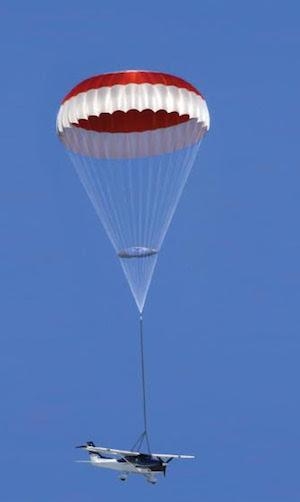Wed, Sep 26, 2018
Will Develop Supplemental Type Certificates For Existing And Planned Aircraft
BRS Aerospace has engaged Wichita State University's National Institute for Aviation Research (WSU-NIAR) to develop testing protocols for evaluating the safety and performance of aircraft parachute recovery systems in GA and VTOL aircraft.

Working with WSU-NIAR's Crash Dynamics and Virtual Engineering laboratories, BRS Aerospace will develop whole aircraft parachute recovery system Supplemental Type Certificates for a range of existing general aviation aircraft and approvals for new models currently under development in addition to advanced VTOL technology.
BRS is the world's leader in whole aircraft parachute recovery systems with more than 35,000 such systems installed on more than 350 models of airplanes. The company is also in the early stages of developing vehicle recovery systems technology that will allow VTOL aircraft to reach safety levels equivalent to standards established in the automotive industry.
"BRS Aerospace is very much looking forward to working with WSU-NIAR at the forefront of developing sophisticated technology and testing protocols which will bring our life-saving expertise to an expanded range of existing and new aircraft in addition to VTOL aircraft," said BRS Aerospace CEO Fernando de Caralt.
"One goal is to support safe autonomous flight over highly populated urban environments. It is a challenge that will require our expertise and the proven abilities of WSU-NIAR to develop thorough testing protocols," he said.
Already working with a number of new VTOL aircraft manufacturers, BRS Aerospace was represented at the UBER Elevate Summit 2018 as one of four critical gap technologies necessary for the successful development of the electric-powered VTOL ecosystem. Uber is promoting electric-powered VTOL urban transportation development.
"Our work with BRS Aerospace in expanding safety technology for a range of aircraft is a great example of public/private partnerships that can simultaneously benefit industry, improve safety and provide applied learning opportunities for students," said Dr. John Tomblin, WSU Vice President for Research and Technology Transfer.
"The partnership with BRS will be key to promoting the integrated safety approach developed at NIAR during the last thirteen years," said Crash Dynamics Laboratory Director Dr. Gerardo Olivares. "We look forward to working with BRS in our current facility and as the first industry collaboration at our new facility under construction at Wichita State."

BRS Aerospace already offers a parachute recovery system as a retrofit to Cessna 172/182 aircraft and as standard equipment on the popular Cirrus line of aircraft. BRS has delivered whole aircraft parachute systems to aviation segments including Light Sport Aircraft, experimental aircraft, ultralights, unmanned vehicles, military aircraft, and FAA/EASA Type Certified airplanes.
A recent independent statistical analysis concluded that when deployed, the ballistic recovery system significantly reduced the odds of experiencing a fatal aircraft accident. BRS has documented a total of 386 lives saved when the ballistic recovery system was deployed.
BRS Aerospace's whole aircraft parachute system for fixed-wing aircraft design calls for a parachute ballistic launcher to be installed in the aircraft with a pilot-initiated activator located in the cockpit. Upon activation, a ballistic rocket propels a parachute into the airstream to slow the airplane and float it down into a survivable vertical landing.
(Images provided with BSR Aerospace news release)
More News
Runway Lead-in Light System Runway Lead-in Light System Consists of one or more series of flashing lights installed at or near ground level that provides positive visual guidance a>[...]
Aero Linx: Aviation Without Borders Aviation Without Borders uses its aviation expertise, contacts and partnerships to enable support for children and their families – at hom>[...]
Dave Juwel's Aviation Marketing Stories ITBOA BNITBOB ... what does that mean? It's not gibberish, it's a lengthy acronym for "In The Business Of Aviation ... But Not In The Busine>[...]
From 2010 (YouTube Version): Yeah.... This IS A Really Cool Job When ANN's Nathan Cremisino took over the lead of our Aero-TV teams, he knew he was in for some extra work and a lot>[...]
Also: Junkers A50 Heritage, Montaer Grows, Dynon-Advance Flight Systems, Vans' Latest Officially, the Carbon Cub UL and Rotax 916 iS is now in its 'market survey development phase'>[...]
 ANN's Daily Aero-Term (04.24.24): Runway Lead-in Light System
ANN's Daily Aero-Term (04.24.24): Runway Lead-in Light System ANN's Daily Aero-Linx (04.24.24)
ANN's Daily Aero-Linx (04.24.24) Aero-FAQ: Dave Juwel's Aviation Marketing Stories -- ITBOA BNITBOB
Aero-FAQ: Dave Juwel's Aviation Marketing Stories -- ITBOA BNITBOB Classic Aero-TV: Best Seat in The House -- 'Inside' The AeroShell Aerobatic Team
Classic Aero-TV: Best Seat in The House -- 'Inside' The AeroShell Aerobatic Team Airborne Affordable Flyers 04.18.24: CarbonCub UL, Fisher, Affordable Flyer Expo
Airborne Affordable Flyers 04.18.24: CarbonCub UL, Fisher, Affordable Flyer Expo




